Table of Content
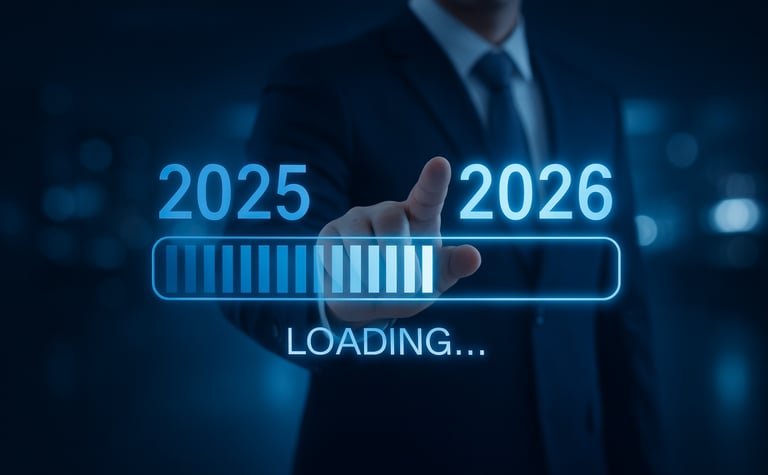

AI maturity, cloud ERP adoption, blockchain-driven trust, security as strategy, and AI-native ERP disruptors.
Hemant Khatod
9/7/20257 min read
Global ERP Spend by 2025
Cloud Based in 2026
CIOs to prioritize AI
HG Insights
IDC
CIO.com


The challenge is clear: ERP must deliver intelligence, agility, automation, and trust — all while controlling costs. For many CIOs, that means addressing five interlinked priorities:
AI maturity — moving from predictive to generative to agentic ERP.
Cloud modernization — shifting fully to SaaS and evaluating AI-native challengers.
ERP architecture choices — deciding between Unified ERP vs Composable ERP models.
Emerging technologies — integrating ERP into digital twins, edge computing, and trusted data networks.
Security & compliance — embedding resilience and trust into ERP by design.
These forces will define how CIOs unlock ERP’s full potential in 2026: not as back-office plumbing, but as a growth platform that powers strategy, decision-making, and operational excellence.
ERP has already evolved beyond record-keeping into predictive decision-making. In 2025, AI copilots and forecasting models became baseline. 82% of CIOs indicated they were tasked with evaluating possible AI additions to their tech stack. In 2026, CIOs will extend this maturity curve with Generative AI and Agentic AI capabilities.
Predictive AI → Forecasts demand, identifies anomalies, and improves planning accuracy.
Generative AI → Creates new content, insights, and workflows (e.g., generating variance explanations, drafting supplier communications, or auto-building reports).
Agentic AI → Goes further by taking action: autonomously creating purchase orders, reconciling accounts, or rebalancing supply chains without human intervention.
Established ERP vendors are embedding this continuum across their platforms (SAP Joule, Oracle’s adaptive AI, Microsoft Copilot), while AI-native disruptors like Campfire and Rillet are purpose-built to automate these steps out of the box.
For CIOs, the priority is not just adopting AI, but building governance frameworks and trust models that let ERP move safely from predictive insights → generative outputs → agentic actions.
Scale predictive AI for forecasting and anomaly detection.
Deploy generative AI for reports, narratives, and workflow creation.
Pilot agentic AI for autonomous ERP actions.
Establish AI governance to balance autonomy with control.
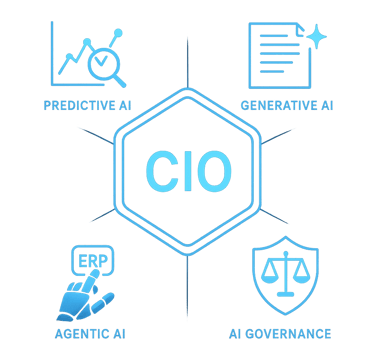

By 2026, the debate over cloud ERP is over. Vendors are concentrating innovation — from AI copilots to compliance updates — exclusively in SaaS editions, forcing laggards to catch up.
But the real disruption comes from a new wave of AI-native ERP challengers. Unlike legacy systems layering AI on top, these platforms are born in the cloud with AI at the core. Campfire, Kick, and Rillet are automating workflows from day one. For example, one Campfire client cut financial close effort by 80% using autonomous reconciliations — a capability legacy ERPs would take years of add-ons to match.
The cloud ERP market in 2026 is evolving in three directions:
Core SaaS ERP → Oracle Fusion, SAP S/4HANA Cloud, Dynamics 365 — global backbones for finance and operations.
Industry Cloud ERP → Vertical editions with compliance prebuilt (e.g., SAP Industry Cloud for Life Sciences, NetSuite SuiteSuccess for Retail).
AI-Native Disruptors → Campfire, Rillet, and others targeting digital-first firms with ERP that predicts, generates, and acts agentically out of the box.
Complete full cloud migration to avoid innovation lockout.
Evaluate AI-native ERPs for new ventures or digital-first units.
Prioritize industry-specific SaaS editions to reduce customization.
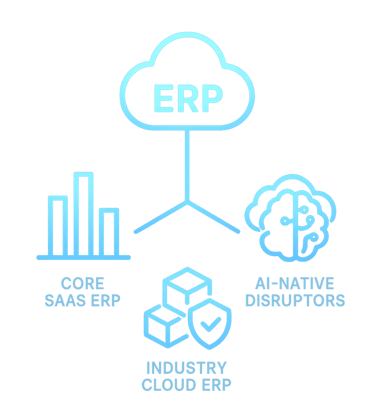

For years, CIOs debated whether ERP should be one unified suite or a composable ecosystem of modules and apps. By 2026, both models are viable — but which one makes sense depends on business context.
What it is: A modular architecture blending a core ERP backbone with specialized apps, API integrations, and low-code extensions.
Best for: Fast-growing, innovation-driven, or diversified organizations that need agility & rapid adoption of new capabilities.
Strengths: Flexibility, faster time-to-value for new modules, easier to plug in AI-driven solutions.
Limits: Requires strong integration discipline, potential for governance complexity.
Example: A digital-first retailer uses NetSuite as a financial core but plugs in a marketplace AI pricing engine, e-commerce platform, and logistics apps — all orchestrated as one ERP ecosystem.
What it is: A single-vendor suite covering finance, HR, supply chain, and more.
Best for: Organizations that value standardization, consistent processes, and one “system of record.”
Strengths: Simplifies governance, reduces integration complexity, delivers strong vendor support.
Limits: Less flexible, slower to adopt new capabilities, risk of vendor lock-in.
Example: A global manufacturing firm running SAP S/4HANA Cloud across 40 countries chose a unified model to enforce global process consistency.
Decide if Unified ERP or Composable ERP aligns with enterprise strategy.
If Unified: focus on global standardization and process governance.
If Composable: invest in integration frameworks and API-first platforms.
In both cases: ensure ERP strategy is future-proof for AI and automation.
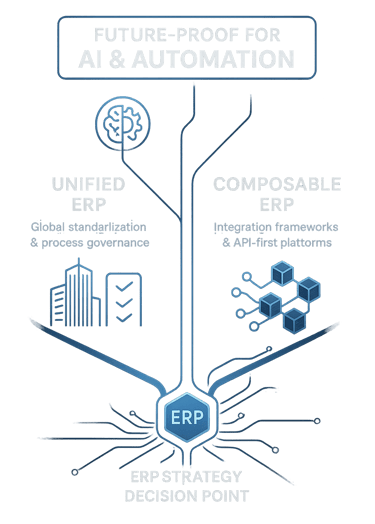

CIOs in 2026 are no longer asking “which is better?” but rather “which is right for us?” The choice depends on scale, risk appetite, and how fast the enterprise needs to adapt
The next frontier isn’t just connecting ERP to everything — it’s embedding ERP into emerging technologies that are moving from pilot to scale. By 2026, CIOs are prioritizing three frontiers:
Digital Twins + Smart Assets → ERP connected to virtual replicas of machines, fleets, and facilities, enabling predictive service and asset intelligence. Instead of waiting for failures, ERP schedules interventions based on real-world usage data.
ERP at the Edge → Manufacturing floors, warehouses, and field service teams are beginning to run ERP-adjacent processes at the edge for real-time execution. Combined with spatial interfaces and AR, ERP tasks like maintenance checks or inventory picking can happen faster and with fewer errors.
Trusted ERP Data Networks → Blockchain and distributed ledgers are emerging as tools for supply chain traceability, ESG reporting, and inter-company workflows. ERP triggers smart contracts or captures immutable supplier data, reducing audit and compliance overhead.
A logistics provider connected digital twins of its fleet to ERP, enabling predictive maintenance scheduling that reduced downtime by 30%. Meanwhile, a healthcare network piloted blockchain-enabled ERP for clinical trial data integrity, meeting compliance requirements without manual audits.
Explore digital twin integration for ERP-driven asset intelligence.
Pilot edge ERP use cases where real-time matters most.
Invest in blockchain-enabled ERP for compliance and trust in multi-party workflows.
Continuously scan for emerging tech ROI — avoid hype, focus on business outcomes.
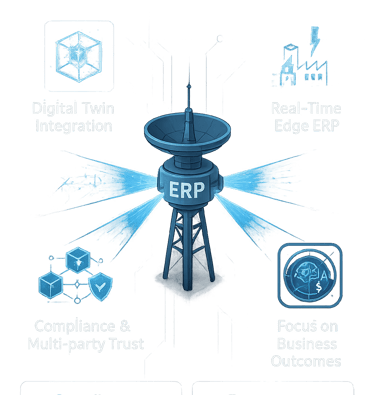

In 2026, ERP security isn’t a box to check — it’s a strategic differentiator. Enterprises face an unprecedented mix of threats and regulations: ransomware targeting ERP data, ESG-driven audit requirements, and national sovereignty laws dictating where data must live.
CIOs are shifting from treating ERP security as IT hygiene to positioning it as a brand asset. Security and compliance readiness now appear in board decks, customer RFPs, and investor updates. Vendors are competing not just on features, but on trust.
What’s new in 2026:
Zero-trust by default → continuous authentication, anomaly detection, and least-privilege access are now expected inside ERP.
Multi-regulation readiness → Enterprises juggle GDPR, CCPA, HIPAA, ESG reporting, and sovereignty rules simultaneously. Modern ERP must manage these out of the box.
Resilience as a selling point → automated failover, SLA-backed uptime, and sovereign clouds are no longer extras — they’re differentiators.
Security posture in the spotlight → Boards, partners, and customers increasingly weigh ERP security when making purchasing and partnership decisions.
A European energy provider selected Oracle Fusion not just for functionality but because of its EU-only sovereign cloud option, satisfying regulators and strengthening customer trust.
Treat ERP security as a board-level KPI and customer trust factor.
Deploy zero-trust ERP architectures with anomaly detection.
Ensure multi-regulation compliance across industries and geographies.
Evaluate ERP vendors on resilience, sovereignty, and security posture.
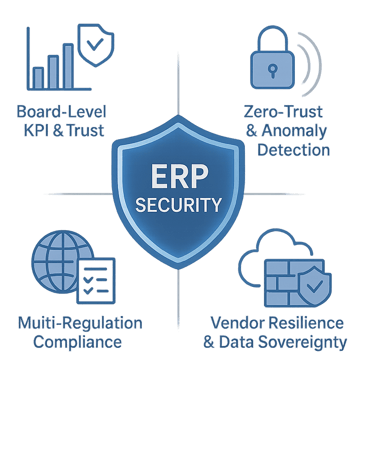

CIOs will succeed by delivering across five priorities:
AI maturity → Evolve ERP from predictive to generative to agentic intelligence.
Cloud modernization → Complete the shift to SaaS and evaluate AI-native challengers.
ERP architecture choices → Decide when Unified ERP brings value vs when Composable ERP drives agility.
Emerging technologies → Integrate digital twins, edge computing, and trusted data networks into ERP workflows.
Security & compliance → Make resilience and trust a board-level differentiator.
Book a Free 30-minute strategy session to get started
Write your text here...
HG Insights – ERP Market Size to Reach $147.7 Billion by 2025
IDC – Worldwide Enterprise Applications Revenue to Reach $385.2 Billion in 2026; Nearly Two-Thirds from Public Cloud
CIO.com (Foundry) – State of the CIO 2025: AI/ML is the #1 technology priority
TechCrunch (June 30, 2025). AI ERP startup Campfire raises $35M
Rimini Street via BusinessWire (Jan 2025). Rootstock AI Survey
Key Success Factors for Integration of Blockchain and ERP Systems: A Systematic Literature Review
Expert guidance for software transformations.
Services
info@aivanceadvisory.com
© 2025. All rights reserved.
